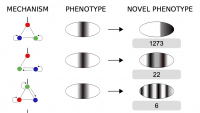 NOTICIAS
NOTICIAS
Evolution is shaped by the underlying dynamical mechanisms in our genome
To what extent does the dynamical mechanism responsible for a specific phenotype bias the ability to evolve into novel phenotypes?
Evolution is driven by mutations which can transform the phenotypic traits of an organism into novel ones, with potential beneficial consequences. This diversification of an original trait can cause both modest morphological changes, such as novel pigmentation patterns in the wings of a butterfly and major evolutionary breakthroughs, such as new body structures – for example the transformation of two-winged insects into four-winged insects (Prud'homme et al 2007).
How phenotypes evolve has been studied in many ways, but one feature – dynamic mechanism - has received little attention. Consider the following analogy: Many human inventions can achieve the function of flight: aeroplanes, hot-air balloons, helicopters, and many more bizarre creations (Figure 1). From a specific functional perspective they all achieve the same “phenotype” – they transport humans by flight, but they each do it in a different way, ie. using a different mechanism. If we were to tinker with these designs, or “mutate” them, to invent a new mode of transport, would they all result in the same new type of vehicle? In this analogy the answer is quite clear: Some of them could be more easily mutated to a driving phenotype, others to a jumping phenotype and some could become space-craft. But how might this principle work at the level of gene regulatory networks (GRNs) in biological systems?

In a new study published this week in PNAS, the Sharpe lab used computer modelling to study the mechanisms employed by small GRNs to achieve a specific desired phenotype. Their model phenotype was a specific multicellular gene expression pattern: a single band of gene expression in the centre of a field of cells (black bands in Figure 1). This is a classic patterning problem during embryo development, when cells in just one part of a tissue must chose a particular fate (for example to become bone cells rather than muscle cells). To create this expression pattern the GRNs must correctly interpret the local concentrations of a morphogen gradient which has different levels at different positions. The GRNs studied were small, 3-node circuits in which genes were wired together with activatory or inhibitory regulatory interactions (see image). Similar to the flying machines, the lab had previously discovered that there were a number of different ways to produce a single band of expression - six dynamical mechanisms which correspond to six distinct network strategies to build a stripe in space and time. In the new study, the group hypothesized that these different mechanisms would also display differences in their evolvability, in other words their capacity to reach novel phenotypes.
The results confirmed this hypothesis, and illustrated that the evolvability could vary in two ways. Firstly, some mechanisms were simply more capable of reaching new phenotypes than others. But secondly, even for two mechanisms with a similar ability to innovate, the new phenotypes accessible could be quite different – for example making multi-stripe patterns in one case, or smooth gradients in another. The key conclusion from this work is that the dynamical mechanism used to build an organism impacts on its evolution. In other words, to understand which new phenotypes can evolve from a given species we have to consider much more than just the existing phenotype – we must also consider the dynamical principles by which the gene networks create that phenotype in the first place.
The observation that the mechanism of a network determines which phenotypes are harder to reach can be described as a kind of constraint on evolution. Already in 1980's Maynard-Smith defined developmental constraints as the “biases on the production of variant phenotypes...caused by the structure, character, composition, or dynamics of the developmental system”. This new study provides a strong theoretical proof that the dynamics of a gene circuit indeed constitutes a specific type of developmental constraint on the search for new phenotypes.
Author: Alba Jiménez, PhD Student, Multicellular Systems Biology Lab.

